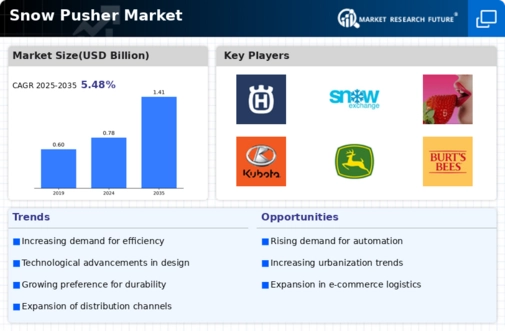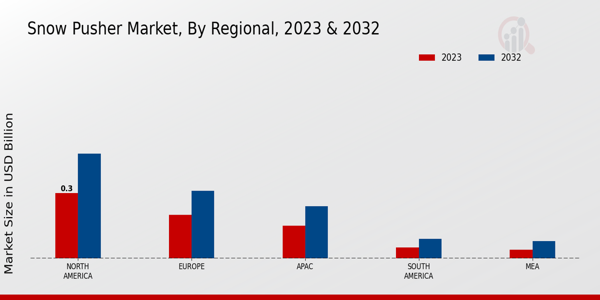Market Growth Projections
The Global Snow Pusher Market Industry is poised for substantial growth, with projections indicating a rise from 0.78 USD Billion in 2024 to 1.41 USD Billion by 2035. This growth trajectory reflects a compound annual growth rate of 5.48% from 2025 to 2035, driven by various factors including technological advancements, increasing urbanization, and heightened demand for efficient snow removal solutions. As the market evolves, it is likely to witness the introduction of innovative products and services that cater to the changing needs of consumers and businesses alike.
Government Initiatives and Regulations
Government initiatives and regulations aimed at enhancing public safety during winter months significantly impact the Global Snow Pusher Market Industry. Many governments implement policies that mandate snow removal in public spaces, thereby increasing the demand for snow pushers among municipalities and contractors. These regulations often include guidelines for timely snow clearance to prevent accidents and ensure mobility. As local governments invest in snow management equipment to comply with these regulations, the market is likely to see a steady increase in sales. This proactive approach to snow management reflects a growing recognition of the importance of effective snow removal strategies.
Environmental Concerns and Sustainable Practices
The Global Snow Pusher Market Industry is increasingly influenced by environmental concerns and the push for sustainable practices. As awareness of climate change and its impacts grows, consumers and businesses alike are seeking eco-friendly snow removal solutions. Snow pushers that minimize environmental impact, such as those designed to reduce fuel consumption or utilize renewable energy sources, are gaining traction. This shift towards sustainability not only aligns with global environmental goals but also appeals to a conscientious consumer base. The market's adaptation to these trends may lead to innovative product offerings that cater to environmentally aware customers.
Technological Advancements in Snow Pusher Design
Technological advancements play a pivotal role in shaping the Global Snow Pusher Market Industry. Innovations in materials and design enhance the performance and durability of snow pushers, making them more appealing to consumers. For instance, the integration of lightweight yet robust materials allows for easier handling and increased efficiency during snow removal operations. Additionally, features such as adjustable blades and ergonomic designs cater to user comfort and effectiveness. As these advancements continue to evolve, they are likely to attract a broader customer base, contributing to the market's projected growth to 1.41 USD Billion by 2035.
Rising Urbanization and Infrastructure Development
The Global Snow Pusher Market Industry is significantly influenced by rising urbanization and infrastructure development. As cities expand and new residential and commercial areas emerge, the need for effective snow management solutions becomes increasingly critical. Urban planners and developers recognize the importance of maintaining clear pathways during winter months, leading to higher investments in snow removal equipment. This trend is particularly pronounced in regions that experience harsh winter conditions, where snow pushers are essential for maintaining accessibility. The anticipated growth in urban infrastructure is expected to bolster the market, supporting a compound annual growth rate of 5.48% from 2025 to 2035.
Increasing Demand for Efficient Snow Removal Solutions
The Global Snow Pusher Market Industry experiences a notable surge in demand for efficient snow removal solutions, driven by the need for timely and effective snow management in urban and rural areas. As municipalities and private sectors prioritize snow clearance to ensure safety and accessibility, the market is projected to reach 0.78 USD Billion in 2024. This trend is particularly evident in regions with heavy snowfall, where the reliance on snow pushers has become essential. The growing awareness of the benefits of mechanized snow removal over traditional methods further propels this demand, indicating a shift towards more advanced snow management technologies.















